Founded in 1942, Oklahoma Farm Bureau has served as a voice for Oklahoma agriculture for generations. Founded by farmers and ranchers, we are proud of our history of standing up for the rights of rural Oklahomans and preserving the way of life that the people of our state love.
To learn more about Oklahoma Farm Bureau history, visit our special history site that was created to celebrate our 75th anniversary. The site features a full history, a timeline of important events and details on the people and programs that have made Oklahoma Farm Bureau what it is today.
The 1940s
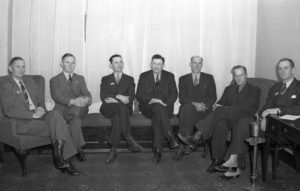
In February of 1942, a delegation of Oklahoma Farmers and Ranchers met at the Huckins Hotel in Oklahoma City to form Oklahoma Farm Bureau. Members met on February 2, 1942, to draft a constitution and bylaws and to elect board members. With 968 charter members paying dues of $5 per year, Oklahoma was the 42nd state to join the American Farm Bureau Federation.
The first Oklahoma Farm Bureau office was opened in the Livestock Exchange building. The first budget was created, copies of bylaws and articles of incorporation was sent to county officers, AFBF publications were distributed with suggested OKFB goals. The organization even had a booth at the State Fair of Oklahoma in 1942 to gain more public exposure.
Within the first few weeks after the historic first meeting, OKFB directors had appointed an insurance committee, which quickly contacted Kansas Farm Bureau Mutual Insurance Company. An arrangement was made the following year to allow OKFB to offer insurance coverage to its members.
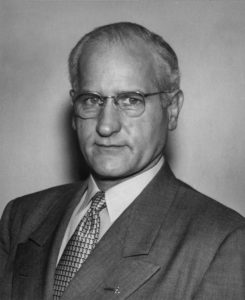
One of the first legislative acts of the organization was to contact the Oklahoma congressional delegation with delegates and members approval of parity pricing legislation that would enable farmers to realize their fair share of the national income.
The first regular OKFB convention was held in the Huckins hotel in Oklahoma City Nov. 4-5, 1942. The first resolutions were created with highlights on their dedication to help win the war with highest possible production goals and the endorsement of the parity principle for agriculture.
OKFB President John I. Taylor and Secretary Dan Arnold made the organization’s first legislative effort to removed sales tax from feed, seed and fertilizer in 1943. Although this attempt failed, the first sales tax success came 14 years later in 1957.
The year of 1943 also marked the beginning of the Associated Women of Oklahoma Farm Bureau. At the formation meeting, the women elected members of the board of directors.
In 1945, OKFB had expanded enough to outgrow their small office in the Livestock Exchange Building. To accommodate this expansion, the organization moved its headquarters to 716 West Grand, which was later renamed to Sheridan Avenue.
Oklahoma Farm Bureau Mutual Insurance Company launched their charter policy campaign May 1, 1946 with a goal of 1,000 charter policies and $100,000 insurance in force by Aug. 1, 1946. At the time, OKFB had 90 agents in 30 counties writing 200 policies a month.
In an effort to encourage the involvement of young people, the Associated Women worked to form a Rural Youth Group. They invited youth to the 1946 state convention, which led the 47 attendees to create their own organization: the Junior Farm Bureau. The organization continued to grow over the years, and its members became actively involved in many areas of Farm Bureau.
Read more about Oklahoma Farm Bureau history during the 1940s on our 75th anniversary website.
1950s
Community activities were widespread throughout OKFB’s membership. Eagerness for learning about farm practices and new technology continued as OKFB frequently encouraged attendance at informational sessions and learning opportunities. In one program, OKFB joined with other organizations to bring young farmer trainees from other countries to live and work on local farms for a certain time.
Support for Junior Farm Bureau members was also apparent through donations to local FFA and 4-H programs as well as encouragement to attend state and national training workshops.
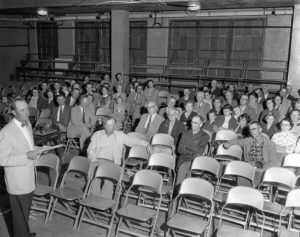
OKFB worked heavily to earn a presence at the State Capitol. At the time, OKFB did not have a staff member to follow pending legislation. Instead, contacts were made primarily by the OKFB president, directors, county leaders and executive secretary. John I. Taylor, Lewis Munn, Dan Arnold and other leaders were familiar figures in legislative halls. These leaders earned respect and contributed to Farm Bureau’s initial reputation. Lawmakers soon recognized OKFB as a reliable source of agricultural information.
In 1957, OKFB led a coalition of farm groups that finally succeeded in getting exemption of feeds and the trade-in value of used farm machinery from sales tax. Ora J. Fox, a leader of the welfare lobby, circulated a petition to call for a statewide vote on the new law, but the courts declared the Fox petition invalid in 1959, when the sales tax exemptions went into effect.
Read more about Oklahoma Farm Bureau history during the 1950s on our 75th anniversary website.
The 1960s
The 1960s started off in the trenches of legislative matters. When the State Equalization mandated a 10-percent hike in ad valorem assessments, Oklahoma Farm Bureau mounted a campaign to challenge the evaluation process. Even though they failed to change the outcome, leaders felt proud to have tried.
In 1963, more than 50 bills that affected agriculture were enacted by the legislature, including land titles, predator control, water and water rights, brands, migrant labor, welfare and annexation sales tax. Additionally, conflicts within the agricultural sector added to OKFB’s legislative workload. With OKFB leading the discussion, fertilizer was added to the list of items exempted from state sales tax in 1965.

With a rapidly growing organization came added benefits and services to members. In response to resolutions from the previous year, OKFB launched a tire-and-battery service in 1964, offering all types of tires and batteries at considerable savings over regular, retail prices.
In 1966, OKFB hired Jim Williams to organize a safety unit in the information division to promote general farm and household safety as well as highway laws and safe driving tips.
With the beginning of the safety service, OKFB began encouraging members to use Slow Moving Vehicle signs, which were designed at the Agricultural Engineering School at Ohio State University for all vehicles not capable of moving faster than 25 miles per hour. OKFB was the state distributor for one of the major manufacturers of the SMV signs, which were sold through county Farm Bureaus.
Read more about Oklahoma Farm Bureau history during the 1960s on our 75th anniversary website.
The 1970s
By the 1970s, Oklahoma Farm Bureau members had harnessed the power of speaking as one voice for agriculture. After a few decades of experience at the state Capitol, OKFB had experienced both successes and failures in a variety of agricultural issues. With the increasing involvement in legislative matters, OKFB leaders recognized the need for a staff member to follow up on pending legislation. OKFB hired Bob Barr as the first legislative specialist in 1970. Barr was a Dover farmer and former legislator.
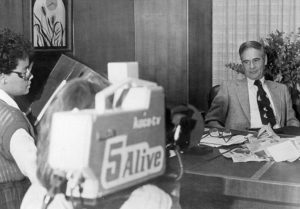
In 1973, strong cattle prices led to increased cattle thefts. To help identify rustlers, legislators suggested livestock trailers be identified by using a mandatory state license tag. To save money and provide an easier option, Oklahoma Farm Bureau members suggested that farmers, ranchers and owners of stock trailers be required to display their drivers license number on the back of their trailers, which also allowed highway patrolmen to check the driver without even stopping the vehicle. The idea was adopted at the OKFB convention in November 1973 and signed into law by Oklahoma Gov. Dan Hall in April 1974, less than six months later.
OKFB also made great strides toward a longtime public policy effort: tax exemptions. After a few successes in the 1960s, sales tax exemption was granted to commercial applicators for fertilizer, poultry stock, seed, repair parts and agricultural chemicals in the early 1970s. After a 35-year-long effort, OKFB finally achieved a blanket exemption of farm inputs from sales taxes in 1978.
Farm Bureau began its reward sign program in 1974, offering $500 rewards for information on crimes committed on Farm Bureau members’ property where the signs were posted. The reward amount later increased to $1,000 in 1988 and to $5,000 in 2006.
The 1970s also saw the expansion of the Oklahoma Farm Bureau home office in Oklahoma City, adding an adjoining structure to the one built in the 1950s.
Read more about Oklahoma Farm Bureau history during the 1970s on our 75th anniversary website.
The 1980s
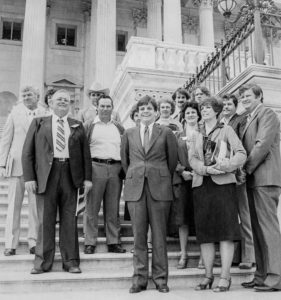
With the lack of agricultural ties to urban areas, the animal rights movement began in the 1980s. At this point, the public was further removed from the farm and began questions farming and ranching practices and techniques. OKFB recognized the need for farmers and ranchers to have the opportunity to tell their story.
With James Lockett as president, OKFB became a leader in agricultural media. When an issue concerning farmers and ranchers arose, media outlets turned to OKFB to speak for the wishes of their members. Lockett spoke with numerous local and national media personnel to define the policies of OKFB and its members on a wide range of issues, such as agricultural pesticides, the cattle market, estate taxes, property rights, and more.
The 1980s saw a string of legislative victories for Oklahoma Farm Bureau, including estate tax exemption changes, water resources development and strengthening litter and trespass laws.
Read more about Oklahoma Farm Bureau history during the 1980s on our 75th anniversary website.
The 1990s
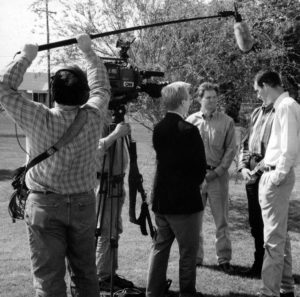
The 1990s brought with it milestones for Oklahoma Farm Bureau as the organization focused on member benefits and programs to enhance the value of becoming an OKFB member. Growth was evident with OKFB membership reaching 100,000 for the first time in 1993.
The decade began with the success of recalling State Question 614 in 1989, which contained controversial changes in the state’s property tax system, including 100 percent assessment rates. However, the fight was not over. During the following years, OKFB led the charge in overhauling ad valorem tax law to help remove burdensome property taxes from farmers and ranchers.
Trade continued to be a major issue in the 1990s. Farm Bureau championed the North American Free Trade Agreement, focusing on its positive impact for agriculture. The measure was implemented in 1994 in hopes to remove barriers to agricultural trade among the U.S., Canada and Mexico.
Read more about Oklahoma Farm Bureau history during the 1990s on our 75th anniversary website.
The 2000s
At the turn of the century, Oklahoma Farm Bureau began advocating for agriculture in new ways through new programs. With membership reaching above 150,000 in 2003, the organization was thriving.
The Oklahoma Farm Bureau Legal Foundation got its start in 2001 for the purpose of entering the legal arena to protect private property rights and production agriculture. The foundation continues to serve farmers and ranchers through engaging in public interest litigation, researching legal issues affecting family farmers and rural Oklahomans, and educating farmers and ranchers and the public about issues important to agriculture. The foundation is funded primarily through voluntary contributions of Farm Bureau members and through fundraising events.
Oklahoma Farm Bureau delegates established the OKAgFund, a political action committee to support candidates for state office, with Farm Bureau members choosing whom to support. In 2004, the OKAgFund reported a 97 percent success rate in backing candidates for public office during primary elections.
Read more about Oklahoma Farm Bureau history during the 2000s on our 75th anniversary website.
The 2010s
The 2010s continue to prove to be a successful decade in the history of OKFB. With new programs and legislative successes, OKFB continues to be the voice of rural Oklahomans in a variety of ways.
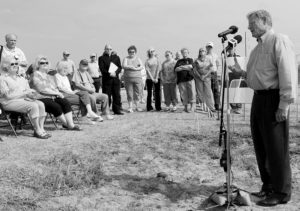
Sustained legislative efforts to protect agriculture from out-of-state interests and unfair taxation provided continued protections for farmers and ranchers growing food for a country and a world that is growing more and more removed from the farm and ranch.
In 2011, the Oklahoma Farming and Ranching Foundation was born, designed to connect consumers with accurate agricultural information while supporting agriculture. The foundation is committed to enhancing awareness and understanding of agriculture’s contribution and importance to the state of Oklahoma. From promoting and assisting beginning farmers and ranchers to educating youth interested in agricultural pursuits, the foundation creates agricultural awareness. Through the foundation, the Beef for Backpacks and Pork for Packs programs have provided hungry children across Oklahoma with an invaluable protein source.
Read more about Oklahoma Farm Bureau history during the 2010s on our 75th anniversary website.
